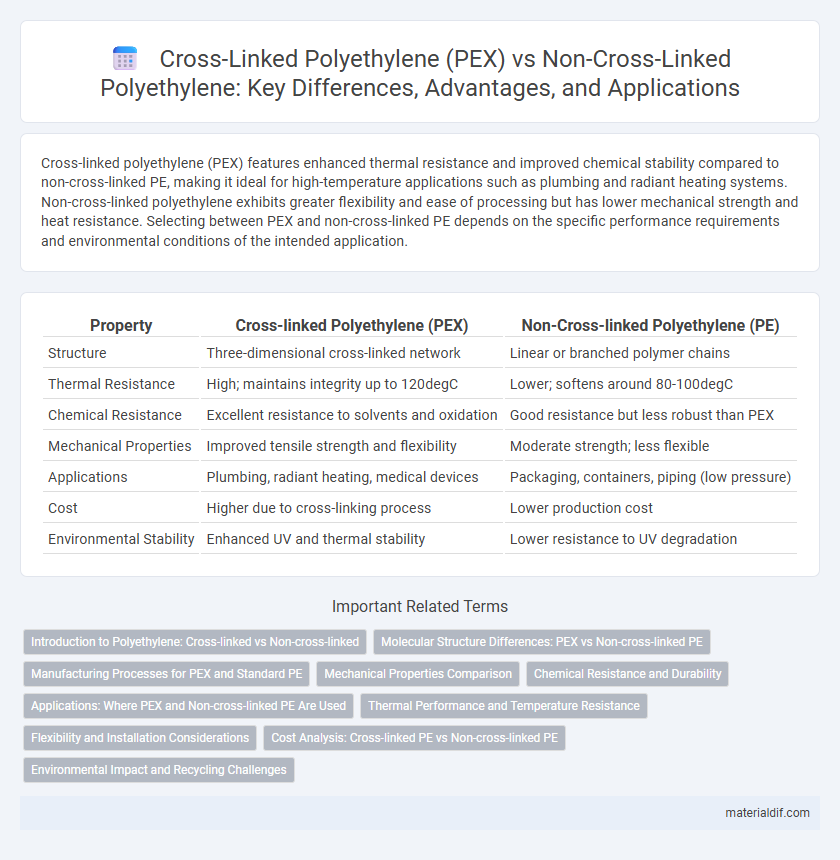Cross-linked polyethylene (PEX) features enhanced thermal resistance and improved chemical stability compared to non-cross-linked PE, making it ideal for high-temperature applications such as plumbing and radiant heating systems. Non-cross-linked polyethylene exhibits greater flexibility and ease of processing but has lower mechanical strength and heat resistance. Selecting between PEX and non-cross-linked PE depends on the specific performance requirements and environmental conditions of the intended application.
Table of Comparison
| Property | Cross-linked Polyethylene (PEX) | Non-Cross-linked Polyethylene (PE) |
|---|---|---|
| Structure | Three-dimensional cross-linked network | Linear or branched polymer chains |
| Thermal Resistance | High; maintains integrity up to 120degC | Lower; softens around 80-100degC |
| Chemical Resistance | Excellent resistance to solvents and oxidation | Good resistance but less robust than PEX |
| Mechanical Properties | Improved tensile strength and flexibility | Moderate strength; less flexible |
| Applications | Plumbing, radiant heating, medical devices | Packaging, containers, piping (low pressure) |
| Cost | Higher due to cross-linking process | Lower production cost |
| Environmental Stability | Enhanced UV and thermal stability | Lower resistance to UV degradation |
Introduction to Polyethylene: Cross-linked vs Non-cross-linked
Cross-linked polyethylene (PEX) features a networked molecular structure created through chemical or physical cross-linking, enhancing its thermal resistance, impact strength, and chemical stability compared to non-cross-linked polyethylene (PE). Non-cross-linked PE maintains a linear or branched polymer chain arrangement, offering flexibility and ease of processing but lower mechanical and thermal performance. Applications of PEX typically target plumbing, heating systems, and insulation, while non-cross-linked PE is used in packaging, containers, and films due to its pliability and cost-effectiveness.
Molecular Structure Differences: PEX vs Non-cross-linked PE
Cross-linked polyethylene (PEX) features covalent bonds forming a three-dimensional network between polymer chains, enhancing thermal stability and mechanical strength. Non-cross-linked polyethylene consists of linear or branched polymer chains without such permanent links, resulting in higher flexibility but lower chemical resistance. The molecular structure differences directly influence the materials' heat resistance, durability, and application suitability.
Manufacturing Processes for PEX and Standard PE
Cross-linked polyethylene (PEX) undergoes a chemical or physical cross-linking process after polymerization, which enhances thermal stability and mechanical properties compared to standard polyethylene produced through polymerization alone. Manufacturing processes for PEX include methods such as peroxide cross-linking, silane cross-linking, and electron beam irradiation, each creating covalent bonds between polymer chains to improve heat resistance and durability. In contrast, non-cross-linked polyethylene (PE) is typically produced via polymerization techniques like high-pressure polymerization for LDPE or Ziegler-Natta and metallocene catalysis for HDPE and LLDPE, resulting in linear or branched chains without intermolecular cross-links.
Mechanical Properties Comparison
Cross-linked polyethylene (PEX) exhibits superior mechanical properties compared to non-cross-linked polyethylene, including enhanced tensile strength, increased impact resistance, and improved dimensional stability under heat. The cross-linking process introduces covalent bonds between polymer chains, resulting in greater elasticity and resistance to deformation under stress. Non-cross-linked PE tends to have lower thermal resistance and mechanical durability, making PEX the preferred choice for applications requiring long-term performance in demanding environments.
Chemical Resistance and Durability
Cross-linked polyethylene (PEX) exhibits superior chemical resistance compared to non-cross-linked PE, effectively withstanding exposure to chemicals such as solvents, acids, and bases. The cross-linking process enhances the polymer's molecular network, significantly improving its durability under thermal stress and mechanical strain. Non-cross-linked PE tends to have lower resistance to cracking and degradation, making PEX the preferred choice for applications requiring long-term chemical and physical stability.
Applications: Where PEX and Non-cross-linked PE Are Used
Cross-linked polyethylene (PEX) is widely used in plumbing systems, radiant heating, and insulation due to its enhanced thermal resistance and durability. Non-cross-linked polyethylene (PE), commonly found in packaging, plastic bags, and containers, is favored for its flexibility and ease of processing. PEX's chemical and temperature resistance make it ideal for demanding applications, while non-cross-linked PE suits less rigorous environments.
Thermal Performance and Temperature Resistance
Cross-linked polyethylene (PEX) exhibits superior thermal performance and higher temperature resistance compared to non-cross-linked polyethylene, withstanding continuous temperatures up to 90-110degC and short-term exposure to 120-160degC. Non-cross-linked PE typically degrades at temperatures above 70-80degC due to its linear molecular structure, limiting its use in high-temperature applications. The cross-linking process in PEX enhances its molecular network, improving thermal stability, chemical resistance, and mechanical strength under elevated temperature conditions.
Flexibility and Installation Considerations
Cross-linked polyethylene (PEX) offers superior flexibility compared to non-cross-linked PE, allowing easier bending and reduced likelihood of kinking during installation. This flexibility facilitates faster and more versatile applications in plumbing and radiant heating systems, especially in tight or complex spaces. Non-cross-linked PE, being stiffer, requires more fittings and careful handling, impacting overall installation time and complexity.
Cost Analysis: Cross-linked PE vs Non-cross-linked PE
Cross-linked polyethylene (PEX) generally involves higher initial manufacturing costs due to the cross-linking process, which enhances thermal stability, chemical resistance, and mechanical strength compared to non-cross-linked PE. Non-cross-linked PE offers lower material and production expenses, making it more economical for applications with less demanding performance requirements. Over the lifecycle, PEX's durability and reduced maintenance needs can offset the upfront cost difference, especially in plumbing and insulation systems.
Environmental Impact and Recycling Challenges
Cross-linked polyethylene (PEX) presents significant environmental challenges due to its chemical cross-linking, which hinders melting and reprocessing, making recycling complex and energy-intensive compared to non-cross-linked polyethylene. Non-cross-linked PE, such as LDPE and HDPE, can be more readily recycled through mechanical processes, reducing landfill accumulation and resource consumption. The environmental impact of PEX is heightened by its resistance to degradation and limited recycling infrastructure, leading to increased waste management difficulties and a larger carbon footprint.
Cross-linked PE (PEX) vs Non-cross-linked PE Infographic

 materialdif.com
materialdif.com